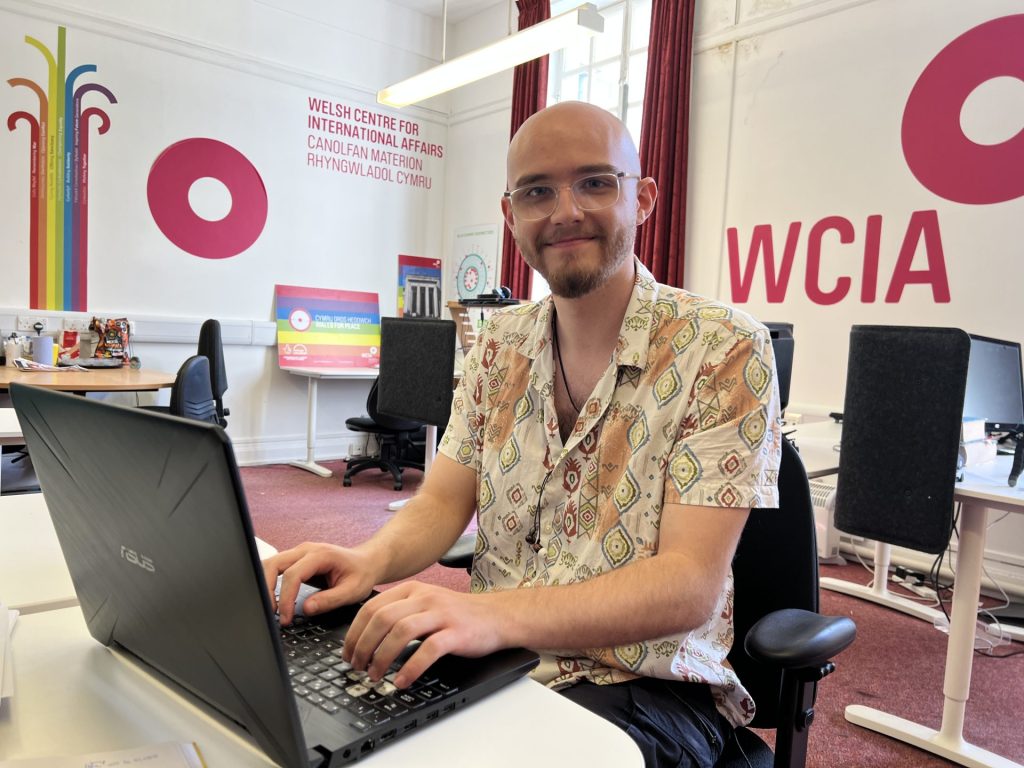Sam Mutter – Placement Review, Minnie James Collection
Sam has recently completed a work experience placement with WCIA, curating and digitising the Minnie James Collection. Mrs James opened the Temple of Peace in 1938 on behalf of the ‘war bereaved mothers of Wales and the world’, having lost 3 sons to WW1 and its aftermath. Her mementoes and archives, thought long lost to history on her passing in 1954, were recently discovered by her family descendents and donated to the Temple Archives for the Temple of Peace anniversary in November 2022. Sam has undertaken the painstaking work of digitising and curating this historic archive for future generations – here is how he did it.

In March of 2023, I started volunteering in a Heritage and Archives Insight with the WCIA and have enjoyed my time working in the Temple of Peace immensely. The first few visits I made to the temple were not strictly relevant to the project I would eventually undertake, but were vital in helping me grasp the layout of the library, as well as the working culture within the organisation. It was a case of me ‘finding my feet’ for the first time within the heritage sector, but once this was done, I began work on the Minnie James Collection, a body of work that I could not be more proud of.
Much was already known of Mrs James and her legacy as a ‘Mother of Wales’ and the opener of the Temple of Peace, however, in November 2023, exciting new developments into her family story were unearthed when her descendants arrived at the temple with a collection of postcards and letters. They were from her sons, who each fought in the trenches of WW1 and tragically died, either directly or indirectly, as a result of the war. My insight brief was very multifaceted, as I was charged with reading through all the letters and postcards, categorising and digitizing them on the People’s Collection Wales and eventually, creating a narrative thread to string them all together on the WCIA website. I was immensely excited by the thought of this brief, as I was going to be able to try my hand at many different aspects of archival work, all within the framework of such an enriching and important collection.

The first half of my insight revolved around the first initial task, to read through all the letters and add them into a list on an excel spreadsheet, describing key details such as the potential date and condition of the item, as well as anything noteworthy about the contents of each letter. All the while doing this, I was enraptured by the stories of these young men and as they were close to my age at the time of writing, it was made all too easy to visualize myself in their shoes and imagine the harsh, brutal reality of war on the western front. David’s letters took up the bulk of my time, with him having over 3x the number to collate. However his story was an important one to begin with, as the majority of his letters were dated, making it far easier to read them with some kind of chronology in mind. This provided much needed context for the wider family’s connections and stories throughout the years of The Great War and this background knowledge would later become vital when reading through the letter’s of the other two brothers. What was so remarkable about reading through each brother’s individual accounts, was how varied each brother’s experience of the war was, with each having a completely unique perspective and interesting aspect of the war to write about, which would all come together to create an immensely wide-reaching overarching narrative.

Once I had finally read through all the letters, I then had to turn my attention to scanning in, digitizing and uploading not only the letters, but all other items of the collection as well. This process was more repetitive and lacked in variety when compared to the excitement of reading through each man’s story. However, it was immensely rewarding to see myself become far more efficient at the tasks as I went through and incredibly satisfying to find workarounds to speed up the process, which will inevitably become vital skills later in my career. This is true of the final task as well, as I had to then collate everything I had done previously to create an engaging narrative for the website. Not only did this allow me to develop my skills in creating web pages, but also allowed me to think about the pacing of my writing, the flow of navigation and how best to tell the story in a manner that did justice to the memory of these brave men.
I know that my time undertaking this insight has been incredibly enriching for my personal skills in the archival and heritage sectors, and I hope that through it I have been able to adequately honour the memory of such a brilliant woman as Minnie James, as well as her unimaginably brave son’s, who were so sadly taken far before their time. Lastly, I want to thank everyone at the WCIA for being so incredibly welcoming and excited to share in their knowledge and passions, and I look forward to continuing my work with you all in my upcoming internship.
